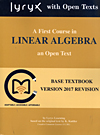- About MAA
- Membership
- MAA Publications
- Periodicals
- Blogs
- MAA Book Series
- MAA Press (an imprint of the AMS)
- MAA Notes
- MAA Reviews
- Mathematical Communication
- Information for Libraries
- Author Resources
- Advertise with MAA
- Meetings
- Competitions
- Programs
- Communities
- MAA Sections
- SIGMAA
- MAA Connect
- Students
- MAA Awards
- Awards Booklets
- Writing Awards
- Teaching Awards
- Service Awards
- Research Awards
- Lecture Awards
- Putnam Competition Individual and Team Winners
- D. E. Shaw Group AMC 8 Awards & Certificates
- Maryam Mirzakhani AMC 10 A Awards & Certificates
- Two Sigma AMC 10 B Awards & Certificates
- Jane Street AMC 12 A Awards & Certificates
- Akamai AMC 12 B Awards & Certificates
- High School Teachers
- News
You are here
A First Course in Linear Algebra

Publisher:
Lyryx Learning
Publication Date:
2017
Number of Pages:
594
Format:
Paperback
Category:
Textbook
[Reviewed by , on ]
Peter T. Olszewski
12/1/2017
Open texts have become more popular over the years for their accessibility and affordability. A First Course in Linear Algebra: an Open Text is another example of an alternative way for students to obtain a solid foundation in linear algebra. Based on the original Linear Algebra text by Kuttler, this open text gives the student the traditional order of topics found in most other linear algebra books with a healthy amount of examples ranging from chemistry to engineering. In addition, there is a pure mathematical side to the text with proofs of important theorems that all linear algebra students will encounter.
From the table of contents, the book is similar to Lay’s Linear Algebra. Starting with chapter 1 on systems of linear equations, the chapter also contains row-reduction, rank, homogeneous systems and applications to resistor networks. With the diversity of the topics and giving a student a preview of more advanced topics early on, the text sets the stage of how powerful and important linear algebra can be.
When it comes down to the pure mathematical side of linear algebra, such as spans, linear independence, subspaces, and bases, the book has clear examples. All of these topics are covered in one section of chapter 4, offering the student a preview, which again is very similar to what is done in Lay’s text. In chapter 9, the last chapter of the text, these topics are presented section by section.
I found that having these pure mathematical topics at the end is an interesting new way to order topics in a linear algebra text. In most books I have read, these pure math topics have been introduced and discussed by chapter 3 or 4. Depending on the type of linear algebra you are teaching, it will be up to the individual instructor how to order the topics.
The introductory example of Eigenvalues and Eigenvectors is a good self-discovery problem. We are given \[ A=\begin{bmatrix}0&5&-10\\0&22&16\\0&-9&-2\end{bmatrix}.\] Students are asked to compute the product \(AX\) for \[ X=\begin{bmatrix}5\\-4\\3\end{bmatrix} \qquad\text{ and }\qquad X=\begin{bmatrix}1\\0\\0\end{bmatrix}\] and then asked if anything can be noticed about \(AX\) in each of the products. This leads the students to \(AX = kX\), where \(k\) is some scalar, which in the definition on page 349 turns into \(AX=\lambda X\). The rest of the chapter includes not only the traditional topics associated with eigenvalues and eigenvectors but also applications on dynamical systems, the Cholesky factorization, and QR factorization.
I would recommend instructors considering this open text as an alternative option for students. This book offers a good amount of problems, application, and proofs for the student and is outlined very well. Each section has measurable goals that a student should be able to do by the end. I may even consider this book myself the next time I teach linear algebra.
Peter Olszewski is a Mathematics Lecturer at The Pennsylvania State University, The Behrend College, an editor for Larson Texts, Inc. in Erie, PA, and is the 362nd Chapter Advisor of the Pennsylvania Alpha Beta Chapter of Pi Mu Epsilon. His Research fields are in mathematics education, Cayley Color Graphs, Markov Chains, and mathematical textbooks. He can be reached at pto2@psu.edu. Webpage: www.personal.psu.edu/pto2. Outside of teaching and textbook editing, he enjoys playing golf, playing guitar and bass, reading, gardening, traveling, and painting landscapes.
The table of contents is not available.
- Log in to post comments




